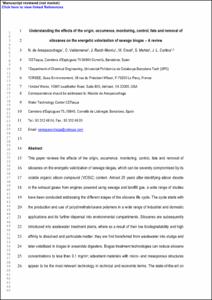Mostra el registre d'ítem simple
Understanding the effects of the origin, occurrence, monitoring, control, fate and removal of siloxanes on the energetic valorization of sewage biogas - A review
| dc.contributor.author | de Arespacochaga, Nicolas |
| dc.contributor.author | Valderrama Ángel, César Alberto |
| dc.contributor.author | Raich-Montiu, Jordi |
| dc.contributor.author | Crest, Marion |
| dc.contributor.author | Mehta, Sumi C. |
| dc.contributor.author | Cortina Pallás, José Luís |
| dc.contributor.other | Universitat Politècnica de Catalunya. Departament d'Enginyeria Química |
| dc.date.accessioned | 2016-01-14T12:42:43Z |
| dc.date.available | 2017-08-01T00:30:39Z |
| dc.date.issued | 2015-08-14 |
| dc.identifier.citation | de Arespacochaga, N., Valderrama, C., Raich-Montiu, J., Crest, M., Mehta, S., Cortina, J. Understanding the effects of the origin, occurrence, monitoring, control, fate and removal of siloxanes on the energetic valorization of sewage biogas - A review. "Renewable and sustainable energy reviews", 14 Agost 2015, vol. 52, p. 366-381. |
| dc.identifier.issn | 1364-0321 |
| dc.identifier.uri | http://hdl.handle.net/2117/81449 |
| dc.description.abstract | This paper reviews the effects of the origin, occurrence, monitoring, control, fate and removal of siloxanes on the energetic valorization of sewage biogas, which can be severely compromised by its volatile organic silicon compound (VOSiC) content. Almost 25 years after identifying silicon dioxide in the exhaust gases from engines powered using sewage and landfill gas, a wide range of studies have been conducted addressing the different stages of the siloxane life cycle. The cycle starts with the production and use of polydimethylsiloxane polymers in a wide range of industrial and domestic applications and its further dispersal into environmental compartments. Siloxanes are subsequently introduced into wastewater treatment plants, where as a result of their low biodegradability and high affinity to dissolved and particulate matter, they are first transferred from wastewater into sludge and later volatilized in biogas in anaerobic digesters. Biogas treatment technologies can reduce siloxane concentrations to less than 0.1 mg/m3; adsorbent materials with micro- and mesoporous structures appear to be the most relevant technology in technical and economic terms. The state-of-the-art on siloxanes is vast and extensive, but there are still some knowledge gaps to be addressed in the future, such as the standardization of the methodology for off-line analysis, the development of on-line monitoring equipment, better understanding the fates of siloxanes in wastewater treatment processes to operate at specific conditions to avoid siloxanes-related problems, the development of more selective and regenerative removal technologies from biogas to reduce operating costs and even to recover silicon, and better understand the detrimental effects on energy recovery technologies to determine the inlet concentration limits. This work compiles the most relevant results available in the literature for each stage of the siloxane life cycle |
| dc.format.extent | 16 p. |
| dc.language.iso | eng |
| dc.subject | Àrees temàtiques de la UPC::Desenvolupament humà i sostenible::Enginyeria ambiental::Tractament de l'aigua |
| dc.subject | Àrees temàtiques de la UPC::Enginyeria química::Química del medi ambient::Química de l'aigua |
| dc.subject.lcsh | Biogas |
| dc.subject.lcsh | Polydimethylsiloxane |
| dc.subject.lcsh | Sewage disposal plants |
| dc.subject.other | Biogas |
| dc.subject.other | Volatile methyl siloxane |
| dc.subject.other | PDMS |
| dc.subject.other | Analysis |
| dc.subject.other | Removal |
| dc.subject.other | Fate |
| dc.subject.other | Energy recovery |
| dc.title | Understanding the effects of the origin, occurrence, monitoring, control, fate and removal of siloxanes on the energetic valorization of sewage biogas - A review |
| dc.type | Article |
| dc.subject.lemac | Biogàs |
| dc.subject.lemac | Energia residual |
| dc.subject.lemac | Aigües residuals -- Plantes de tractament |
| dc.contributor.group | Universitat Politècnica de Catalunya. SETRI - Grup de Tècniques de Separació i Tractament de Residus Industrials |
| dc.identifier.doi | 10.1016/j.rser.2015.07.106 |
| dc.relation.publisherversion | http://www.sciencedirect.com/science/article/pii/S1364032115007534 |
| dc.rights.access | Open Access |
| local.identifier.drac | 17282739 |
| dc.description.version | Postprint (author's final draft) |
| local.citation.author | de Arespacochaga, N.; Valderrama, C.; Raich-Montiu, J.; Crest, M.; Mehta, S.; Cortina, J. |
| local.citation.publicationName | Renewable and sustainable energy reviews |
| local.citation.volume | 52 |
| local.citation.startingPage | 366 |
| local.citation.endingPage | 381 |
Fitxers d'aquest items
Aquest ítem apareix a les col·leccions següents
-
Articles de revista [186]
-
Articles de revista [2.227]


